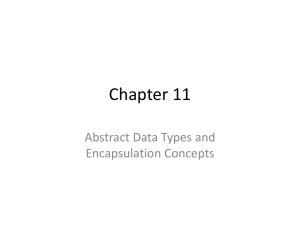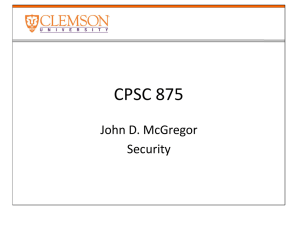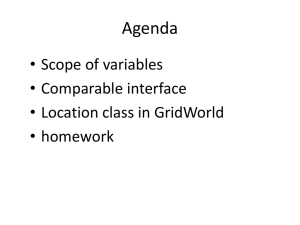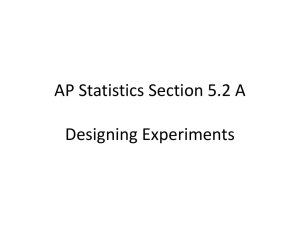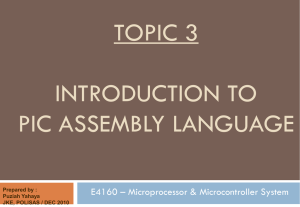PPT
advertisement
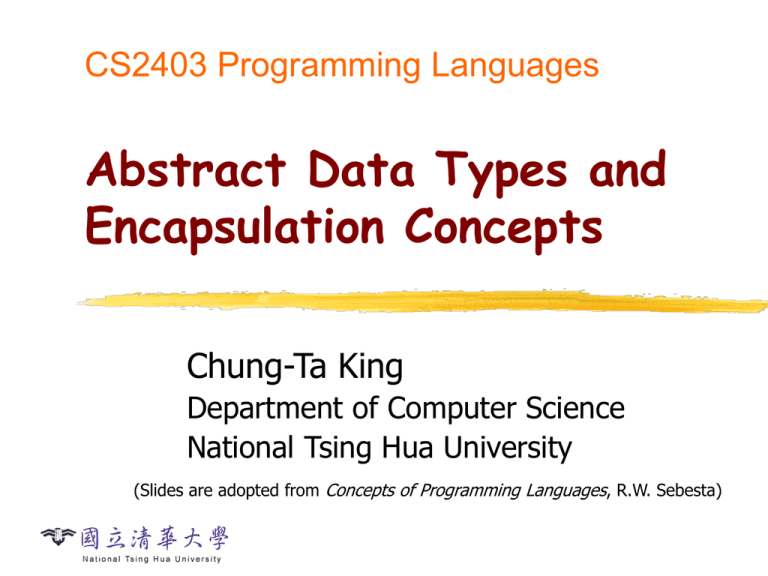
CS2403 Programming Languages
Abstract Data Types and
Encapsulation Concepts
Chung-Ta King
Department of Computer Science
National Tsing Hua University
(Slides are adopted from Concepts of Programming Languages, R.W. Sebesta)
What is object-oriented paradigm?
1
A Simple Shooting Game
2
Object-Oriented Programming
Think from the perspectives of data (“things”)
and their interactions with the external world
Object
Data
Method: interface and message
Class
The need to handle similar “things”
American, French, Chinese, Korean abstraction
Chinese: northerners, southerners inheritance
Dynamic binding, polymorphism
3
What OOP Allows You?
You analyze the objects with which you are
working (attributes and tasks on them)
You pass messages to objects, requesting them
to take action
The same message works differently when
applied to the various objects
A method can work with different types of data,
without the need for separate method names
Objects can inherit traits of previously created
objects
Information can be hidden better
(Object-Oriented Programming Using C++)
4
Outline
The Concept of Abstraction (Sec. 11.1)
Introduction to Data Abstraction (Sec. 11.2)
Design Issues (Sec. 11.3)
Language Examples (Sec. 11.4)
Parameterized Abstract Data Types (Sec. 11.5)
Encapsulation Constructs (Sec. 11.6)
Naming Encapsulations (Sec. 11.7)
5
Abstraction
Two types of abstractions:
Floating-point data type as data abstraction
Process abstraction: subprograms
Data abstraction
The programming language will provide (1) a way of
creating variables of the floating-point data type, and
(2) a set of operators for manipulating variables
Abstract away and hide the information of how the
floating-point number is presented and stored
Need to allow programmers to do the same
Allow them to specify the data and the operators
6
Abstraction Data Type
Abstract data type: a user-defined data type
Declaration of the type and protocol of operations on
objects of the type, i.e., type’s interface, are defined
in a syntactic unit; interface indep. of implementation
Representation of objects of the type is hidden from
program units that use these objects; only possible
operations are those provided in type's definition
class
data type
int
object
variable
i, j, k
method
operators
+, -, *, /
y = stack1.top()+3; vs y = (-x) + 3;
7
Advantages of Data Abstraction
Advantage of having interface independent of
object representation or implementation of
operations:
Program organization, modifiability (everything
associated with a data structure is together),
separate compilation
Advantage of 2nd condition (info. hiding)
Reliability: By hiding data representations, user code
cannot directly access objects of the type or depend
on the representation, allowing the representation to
be changed without affecting user code
8
Language Requirements for ADTs
A syntactic unit to encapsulate type definition
A method of making type names and
subprogram headers visible to clients, while
hiding actual definitions
Some primitive operations that are built into the
language processor
Example: an abstract data type for stack
create(stack), destroy(stack), empty(stack),
push(stack, element), pop(stack), top(stack)
Stack may be implemented with array, linked list, ...
9
Outline
The Concept of Abstraction (Sec. 11.1)
Introduction to Data Abstraction (Sec. 11.2)
Design Issues (Sec. 11.3)
Language Examples (Sec. 11.4)
Parameterized Abstract Data Types (Sec. 11.5)
Encapsulation Constructs (Sec. 11.6)
Naming Encapsulations (Sec. 11.7)
10
Abstract Data Types in C++
Based on C struct type and Simula 67 classes
The class is the encapsulation device
All of the class instances of a class share a single
copy of the member functions
Each instance has own copy of class data members
Instances can be static, stack dynamic, heap dynamic
Information hiding
Private clause for hidden entities
Public clause for interface entities
Protected clause for inheritance (Chapter 12)
11
Member Functions Defined in Class
class Stack {
private:
int *stackPtr, maxLen, topPtr;
public:
Stack() { // a constructor
stackPtr = new int [100];
maxLen = 99;
topPtr = -1;
};
~Stack () {delete [] stackPtr;};
void push (int num) {…};
void pop () {…};
int top () {…};
Implicitly inlined code
int empty () {…};
placed in caller’s code
}
12
Language Examples: C++ (cont.)
Constructors:
Functions to initialize the data members of instances
(they do not create the objects)
May also allocate storage if part of the object is
heap-dynamic
Can include parameters to provide parameterization
of the objects
Implicitly called when an instance is created
Can be explicitly called
Name is the same as the class name
13
Language Examples: C++ (cont.)
Destructors
Functions to clean up after an instance is destroyed;
usually just to reclaim heap storage
Implicitly called when the object’s lifetime ends
Can be explicitly called
Name is the class name, preceded by a tilde (~)
Friend functions or classes: to allow access to
private members to some unrelated units or
functions (see Section 11.6.4)
Necessary in C++
14
Uses of the Stack Class
void main()
{
int topOne;
Stack stk; //create an
the Stack
stk.push(42); // c.f.,
stk.push(17);
topOne = stk.top(); //
stk.pop();
...
}
instance of
class
stk += 42
c.f., &stk
15
Member Func. Defined Separately
// Stack.h - header file for Stack class
class Stack {
private:
int *stackPtr, maxLen, topPtr;
public:
Stack(); //** A constructor
~Stack(); //** A destructor
void push(int);
void pop();
int top();
int empty();
}
16
Member Func. Defined Separately
// Stack.cpp - implementation for Stack
#include <iostream.h>
#include "Stack.h"
using std::cout;
Stack::Stack() { //** A constructor
stackPtr = new int [100];
maxLen = 99;
topPtr = -1;}
Stack::~Stack() {delete[] stackPtr;};
void Stack::push(int number) {
if (topPtr == maxLen)
cerr << "Error in push--stack is full\n";
else stackPtr[++topPtr] = number;}
...
17
Abstract Data Types in Java
Similar to C++, except:
All user-defined types are classes
All objects are allocated from the heap and accessed
through reference variables
Methods must be defined completely in a class
an abstract data type in Java is defined and
declared in a single syntactic unit
Individual entities in classes have access control
modifiers (private or public), rather than clauses
No destructor implicit garbage collection
18
An Example in Java
class StackClass {
private int [] stackRef;
private int maxLen, topIndex;
public StackClass() { // a constructor
stackRef = new int [100];
maxLen = 99;
topPtr = -1;};
public void push (int num) {…};
public void pop () {…};
public int top () {…};
public boolean empty () {…};
}
19
An Example in Java
public class TstStack {
public static void main(String[] args) {
StackClass myStack = new StackClass();
myStack.push(42);
myStack.push(29);
System.out.println(“:“+myStack.top());
myStack.pop();
myStack.empty();
}
}
20
“Hello World!” Compared
C++
C
#include <stdio.h>
int main(void){
print("Hello world!");
}
Java
#include <iostream>
using namespace std;
int main(){
cout<<"Hello World!"<<endl;
}
Ruby
public class HelloWorld {
public static void
main(String[] args){
System.out.println
("Hello world!");
}
}
puts 'Hello, world!'
or
class String
def say
puts self
end
end
'Hello, world!'.say
(http://en.wikibooks.org/wiki/Hello_world_program)
21
Outline
The Concept of Abstraction (Sec. 11.1)
Introduction to Data Abstraction (Sec. 11.2)
Design Issues (Sec. 11.3)
Language Examples (Sec. 11.4)
Parameterized Abstract Data Types (Sec. 11.5)
Encapsulation Constructs (Sec. 11.6)
Naming Encapsulations (Sec. 11.7)
22
Parameterized ADTs
Parameterized abstract data types allow
designing an ADT that can store any type
elements (among other things): only an issue
for static typed languages
Also known as generic classes
C++, Ada, Java 5.0, and C# 2005 provide
support for parameterized ADTs
23
Parameterized ADTs in C++
Make Stack class generic in stack size by writing
parameterized constructor function
class Stack {
...
Stack (int size) {
stk_ptr = new int [size];
max_len = size - 1; top = -1; };
...
}
Stack stk(150);
24
Parameterized ADTs in C++ (cont.)
Parameterize element type by templated class
template <class Type>
class Stack {
private:
Type *stackPtr;
int maxLen, topPtr;
public:
Stack(int size) {
stackPtr = new Type[size];
maxLen = size-1; topPtr = -1; }
...
Stack<double> stk(150);
Instantiated by compiler
25
Outline
The Concept of Abstraction (Sec. 11.1)
Introduction to Data Abstraction (Sec. 11.2)
Design Issues (Sec. 11.3)
Language Examples (Sec. 11.4)
Parameterized Abstract Data Types (Sec. 11.5)
Encapsulation Constructs (Sec. 11.6)
Naming Encapsulations (Sec. 11.7)
26
Generalized Encapsulation
Enclosure for an abstract data type defines a
SINGLE data type and its operations
How about defining a more generalized
encapsulation construct that can define any
number of entries/types, any of which can be
selectively specified to be visible outside the
enclosing unit
Abstract data type is thus a special case
27
Encapsulation Constructs
Large programs have two special needs:
Some means of organization, other than simply
division into subprograms
Some means of partial compilation (compilation units
that are smaller than the whole program)
Obvious solution: a grouping of logically related
code and data into a unit that can be separately
compiled (compilation units)
Such collections are called encapsulation
Example: libraries
28
Means of Encapsulation: Nested
Subprograms
Organizing programs by nesting subprogram
definitions inside the logically larger
subprograms that use them
Nested subprograms are supported in Ada,
Fortran 95, Python, and Ruby
29
Encapsulation in C
Files containing one or more subprograms can
be independently compiled
The interface is placed in a header file
Problem:
The linker does not check types between a header
and associated implementation
#include preprocessor specification:
Used to include header files in client programs to
reference to compiled version of implementation file,
which is linked as libraries
30
Encapsulation in C++
Can define header and code files, similar to
those of C
Or, classes can be used for encapsulation
The class header file has only the prototypes of the
member functions
The member definitions are defined in a separate file
Separate interface from implementation
Friends provide a way to grant access to private
members of a class
Example: vector object multiplied by matrix object
31
Friend Functions in C++
class Matrix;
class Vector {
friend Vector multiply(const Matrix&,
const Vector&);
... }
class Matrix {
friend Vector multiply(const Matrix&,
const Vector&);
... }
Vector multiply(const Matrix& ml,
const Vector& vl) {
... }
32
Naming Encapsulations
Encapsulation discussed so far is to provide a
way to organize programs into logical units for
separate compilation
On the other hand, large programs define many
global names; need a way to avoid name
conflicts in libraries and client programs
developed by different programmers
A naming encapsulation is used to create a new
scope for names
33
Naming Encapsulations (cont.)
C++ namespaces
Can place each library in its own namespace and
qualify names used outside with the namespace
namespace MyStack {
... // stack declarations
}
Can be referenced in three ways:
MyStack::topPtr
using MyStack::topPtr;
p = topPtr;
using namespace MyStack; p = topPtr;
C# also includes namespaces
34
Naming Encapsulations (cont.)
Java Packages
Packages can contain more than one class definition;
classes in a package are partial friends
Clients of a package can use fully qualified name,
e.g., myStack.topPtr, or use import declaration,
e.g., import myStack.*;
Ada Packages
Packages are defined in hierarchies which correspond
to file hierarchies
Visibility from a program unit is gained with the with
clause
35
Naming Encapsulations (cont.)
Ruby classes are name encapsulations, but Ruby
also has modules
Module:
Encapsulate libraries of related constants and
methods, whose names in a separate namespace
Unlike classes cannot be instantiated or
subclassed, and they cannot define variables
Methods defined in a module must include the
module’s name
Access to the contents of a module is requested with
the require method
36
Ruby Modules
module MyStuff
PI = 3.1415
def MyStuff.mymethod1(p1)
...
end
def MyStuff.mymethod(p2)
...
end
end
Require ‘myStuffMod’
myStuff.mymethod1(x)
37
Summary
Concept of ADTs and the use in program design
was a milestone in languages development
Two primary features are packaging of data with their
associated operations and information hiding
C++ data abstraction is provided by classes
Java’s data abstraction is similar to C++
Ada, C++, Java 5.0, and C# 2005 support
parameterized ADTs
C++, C#, Java, Ada, and Ruby provide naming
encapsulations
38
